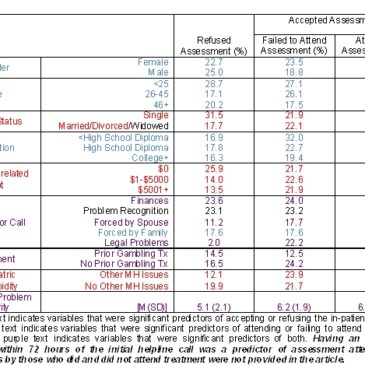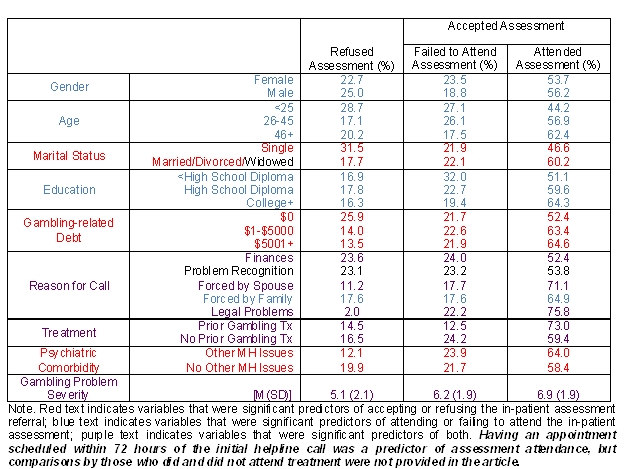Few people who experience gambling problems seek help for those problems (Slutske, 2006). Some of these untreated individuals recover on their own. Others who might benefit from treatment avoid it due to ambivalence or barriers. For this second group, first points of contact might serve as important opportunities to promote treatment engagement. This week, the WAGER reviews a study that investigated factors that predict treatment engagement among individuals calling a gambling problem helpline (Weinstock et al., 2011).
Method
- Participants were 2,912 individuals who called the West Virginia gambling problem helpline and were offered in-person assessments; 82% of these participants qualified as pathological gamblers (PGs).
- Helpline staff conducted interviews with each caller, collecting information about demographics, gambling activity, gambling problems, other mental health issues, and previous treatment.
- Researchers recorded whether callers accepted the offer of an in-person assessment, whether they attended the assessment, and how soon after the helpline call the assessment was scheduled to occur.
Results
- 76% of the helpline callers agreed to participate in an in-person assessment, and 72% of those (55% of the full sample) actually attended the assessment. Table 1 displays the significant predictors of assessment acceptance and attendance.
- In a logistic regression model predicting in-person assessment acceptance:
- being single and having received previous treatment predicted refusal of the in-person assessment offer;
- high gambling debt, calling due to spousal pressure or legal problems, gambling problem severity, and other mental health problems all predicted accepting the in-person assessment.
- In another logistic regression model, predicting assessment attendance among those who had accepted the in-person assessment offer:
- being female and being younger predicted failure to attend the in-person assessment;
- having a higher education level, calling due to spousal/familial pressure or legal problems, having received previous treatment, and gambling problem severity all predicted attending the in-person assessment;
- receiving an appointment within 72 hours of calling the helpline, accomplished for 57% of the sample, was also strongly predictive of assessment attendance.
- Employment, income, suicidal ideation, and gambling patterns and frequency did not have discernable effects on assessment acceptance or attendance.
Table 1. Significant predictors of assessment acceptance and attendance among gambling problem helpline callers.
Limitations
- Though this study tells us what predicts treatment engagement, it does not tell us about the efficacy of that treatment or participants’ receptiveness to the session, once there.
- We do not know whether those who refused or failed to attend the assessment got worse or better without treatment.
Conclusion
This study provides information about personal and situational characteristics that influence not only willingness to pursue treatment, but also ability to follow through. Though demographics did not have a strong influence on whether helpline callers accepted an offer of in-person assessment, they did affect whether callers attended that assessment. This suggests that certain demographic factors, such as being female, younger, and having a lower education, might be associated with barriers to treatment. These potential barriers, such as family burden, deserve further attention. At the same time, efforts to make treatment immediately available (i.e., within 72 hours) appear to facilitate treatment engagement. In addition, family involvement had a positive effect on treatment-seeking and attendance in this study; it remains to be seen whether such coerced entry into treatment has a positive or negative effect on treatment outcome.
-Sarah Nelson
What do you think? Please use the comment link below to provide feedback on this article.
References
Slutske, W. S. (2006). Natural recovery and treatment-seeking in pathological gambling: results of two U.S. national surveys. Am J Psychiatry, 163(2), 297-302.
Weinstock, J., Burton, S., Rash, C. J., Moran, S., Biller, W., Krudelbach, N., et al. (2011). Predictors of engaging in problem gambling treatment: data from the West Virginia Problem Gamblers Help Network. Psychol Addict Behav, 25(2), 372-379.





